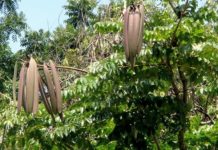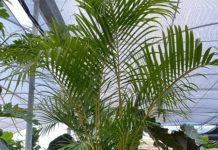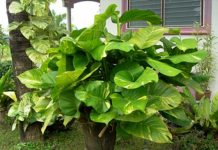Last Updated on 23 กุมภาพันธ์ 2023 by puechkaset
Water chestnut is a marginal plant and its corm is commonly eaten, especially Chinese water chestnut with a large corm, dense meat, white color and sweet taste, which is often boiled or processed as canned products and as flour for cooking foods or desserts.
Chinese water chestnut is widely planted and eaten nowadays because of its large corm with white meat and sweet taste and can be processed into various products.
Taxonomy
Phylum: Spermatophyta
Class: Angiospermae
Order: Cyperales
Family: Cyperaceae
Genus: Eleocharis
Species: dulcis
• Scientific name: Eleocharisdulcis Trin.
• Synonyms of science:
– E. tuberosa Schult.
– Scirpus tuberosus Roxb.
• Common name:
– CHINESE WATER CHESTNUT
Types
1. Water chestnut weed
This type of water chestnut has a small stem and is a weed that is mostly found in all countries of Southeast Asia. It is characterized by its small, short and rounded stem that is lower than its leaves. When flowering, its peduncles can be higher than 30 cm. Its root produces long stolons and its corms occur on these stolons. Its corm is small about 0.3-0.8 mm and is covered with black and brown sheet. The meat of its corm is white, solid and spicy and is used as a medicinal herb in many recipes.
2. Water chestnut for eating its corm
This type of water chestnut is mostly planted in Thailand. Its stem is approximately 80 to 1.5 meters high and its leaves are rounded like garlic-shaped grasses and look triangular. Its corm has a spherical and relatively flat shape and the peel of its corm is black or dark brown. The meat of its corm is white and it turns to pale yellow or transparently white when boiled.
Origin and spreading
Chinese water chestnut is native to and was first planted in China. Later, it has been commonly planted in the warm countries, including India, the Philippines, the United States of America, and countries in South America.
Botanical characteristics
Root and corm
Its root is of rhizome or corm type with a sprouting of stolons and new corms. Its corm has a spherical and relatively flat shape and can be divided into two types as follows:
First type: Its corm occurs when this plant is 6-8 weeks old, is small, and serves to sprout its seedlings surrounding its own plant.
Second type: Its corm occurs during or after flowering at the stem base with an angle of 45 degrees to its stem and is larger than the first type. Initially, the peel of its corm is white and later is covered with dark brown scales. The size of this corm that is commonly harvested and sold is approximately 2-3.5 cm. One water chestnut can produce about 7-10 corms.
Stem
This plant is in the same family as papyrus and is an one-year plant. Its stem is rounded, erect, solid and succulent with a height of 1-1.5 meters.
Leaf
Its leaf is simple, rounded and long and its leaf blade is green.
Flower
This plant flowers as a bouquet at its stem apex and each bouquet contains many florets with perfect flower peduncles. Its female flowers come first when the stem is about 15 centimeters high followed by its male flowers.

Fruit
Its fruit is often called as seed that is small and blackish brown.

Benefits of water chestnut
1. Its fresh corm is usually washed and boiled for 30-40 minutes before eating, and its meat is white, crisp and sweet.
2. Its corm is boiled, peeled and mixed with other types of cereals to make desserts or foods, such as fillings of buns and puddings.
3. Its raw corm is peeled, chopped, dried and ground as powder for making foods or desserts with same property as corn flour.
4. Its boiled corm is peeled and processed as canned products in syrup.
5. Its small corm is used for feeding animals, such as cattle and pigs.
6. Its stem is used for feeding animals or is dried, cut into strips, and woven into mats, baskets, hats or other appliances.
Pharmaceutical effects
Rhizome
– Chinese truffle has a substance called “Puchin” that has many properties such as anti-inflammatory. Antibacterial
– Helps to nourish the body
– Helps to reduce fat in the blood vessels
– Relieve diabetes
– Solve thirst
– Stimulate digestion
– Helps reduce fever
– solve the heat in
– Helps to drive milk
– Helps heal wounds in the gastrointestinal tract
– Helps resolve nausea and vomiting
– Stimulate appetite in children
– Cure cough
– cure constipation
– Solve the symptoms of drunkenness
– Helps relieve hemorrhoids
– Helps to relieve copper poisoning
– Cure measles
– Water chestnuts were peeled and crushed before applying warts to help soften warts.
Growing
It is a marginal plant that grows only in a flooding area and prefers loose soil mixed with clay or mud.
Seedling corm preparation
A good seedling corm should have a size of 3 cm or more and be intact with no atrophy or biting mark of insects. Approximately three tanks of corms, or 2,000 corms, are used per rai of land.
Seedling cultivation
Growting land for this plant is made with single-story bricks with a width of about 1 m and an appropriate length before being sprinkled with rice husk ash or rice husk ash mixed with farm yard manure with a thickness of about 5 cm.
Its seedling corm is dried for 2-3 days and then soaked in water for 2-3 days until its young sprout occurs. Then, it is moved into growing plan with a 3-5 cm space between its corms and rows and all corms are covered with ashes before watering and maintaining them until they are 30-45 days or with a height of 20-25 cm before being moved to the field. The farmers usually plant their seedlings around January to February.
Land preparation
A land preparation should be completed 1-2 days in advance prior to the growing readiness of seedlings. This land preparation is similar to the paddy mire preparation that consists of plowing and drying of soil for 7-10 days and then bringing the water into the growing land with a height of about 10-15 cm before plowing the land as mire again.
Growing method
This plant is planted by trans growing like doing in a paddy field and its trans growing space ranges from 50 x 50 cm to 70 x 70 cm by putting its corms completely under the mud. The farmers will start growing during March and April and harvesting the corms in November when they are at the age of 6-8 months, but this may vary in different areas.
Caring of water level
After trans growing, the water level in the growing land should be maintained at 10-15 cm by making a groove to draw or drain the water around the plot in order to pump in the water if the water is too low and to pump out the water if the water is too high.
Elimination of weeds, diseases and insects
Most farmers often spray herbicides and insecticides for eliminating the following grasses, insects and diseases:
Rust fungus disease is a disease caused by fungi that provides leaves with an orange-brown or rust-like lesion. This disease can be treated by spraying Dithane M-45 and Benfos every seven days.
Orange leaf disease is also caused by fungi, but it is very serious. It can be treated with a method similar to the rust fungus disease.
Stem borer is a worm that eats leaf fibers. In case of outbreak, Carbofuran and Isazofos should be sprayed.
Leafhopper is an aphid that sucks the stem nutrients. It can be eliminated by spraying Monodrofos, Carbosulfan or other types of pesticide.
Use of fertilizers
The fertilizers is firstly used 15-20 days after trans growing by putting chemical fertilizers 14-14-21 or 15-15-15 at a rate of 20-30 kg / rai.
The fertilizers is secondly used 90-120 days after trans growing or 75-100 days after first use of fertilizers by putting chemical fertilizers 14-14-21 at the same rate.
Corm harvesting and storage
Its corms can be harvested when their age is about 7-8 months after growing or after 6 months or later when their leaves turn to golden yellow or brown and start wilting as well as when the peel of these corms is dark brown. Generally, the farmers harvest these corms during November to December that is the same period as rice harvesting. An appropriate size of corms is 3 cm or bigger.
Harvesting of these corms begins with releasing water from their growing land 3-4 weeks in advance prior to harvesting day so that the soil surface is dry. Then, the soil is plowed with a depth of about 15 cm before harvesting the corms or using a hoe to collect the corms. However, in some areas where water drainage is difficult, the farmers harvest these corms by their hands by stepping on the mud around the stems into a circle or making the mud into a chunk and then using their hands to lift up the mud together with corms.
Water chestnuts aged 7-8 months in Thailand will produce 3-4 tons of their corms per rai and 3-6.4 tons per rai for other countries.
After these corms are harvested from their growing land, for next breeding, they should be kept in a sack in the shade or in a wooden crate or sandbox, which can be stored for 6 months.
Price of Chinese water chestnut and where to sell
In Thailand during harvest season in October – early November, the price of raw Chinese water chestnuts is about 60 baht / tank or slightly higher, while at the end of harvest season in December, the price will increase up to 80-150 baht / tank. Big and small peeled Chinese water chestnuts cost about 24 and 13 baht per kg, respectively.



